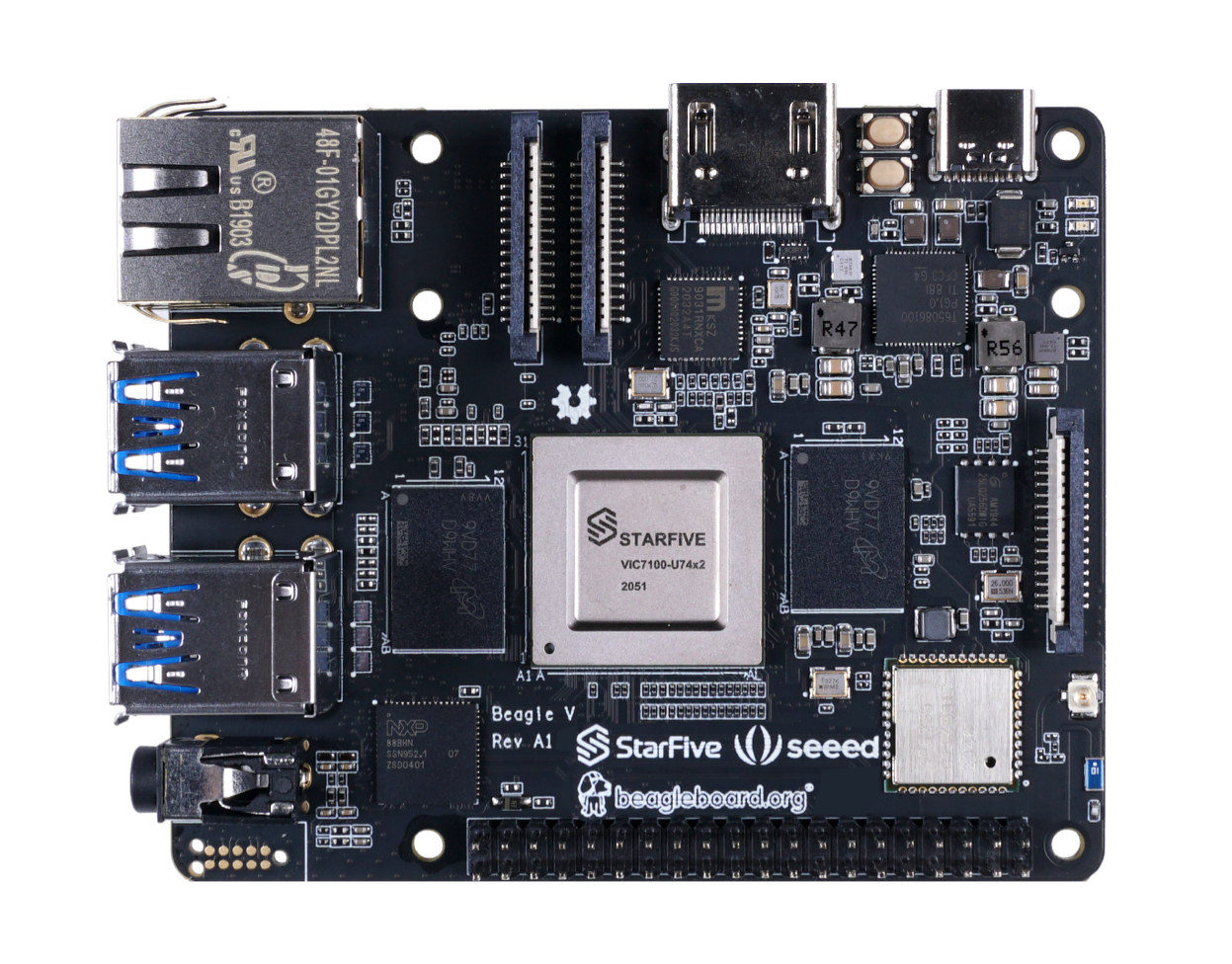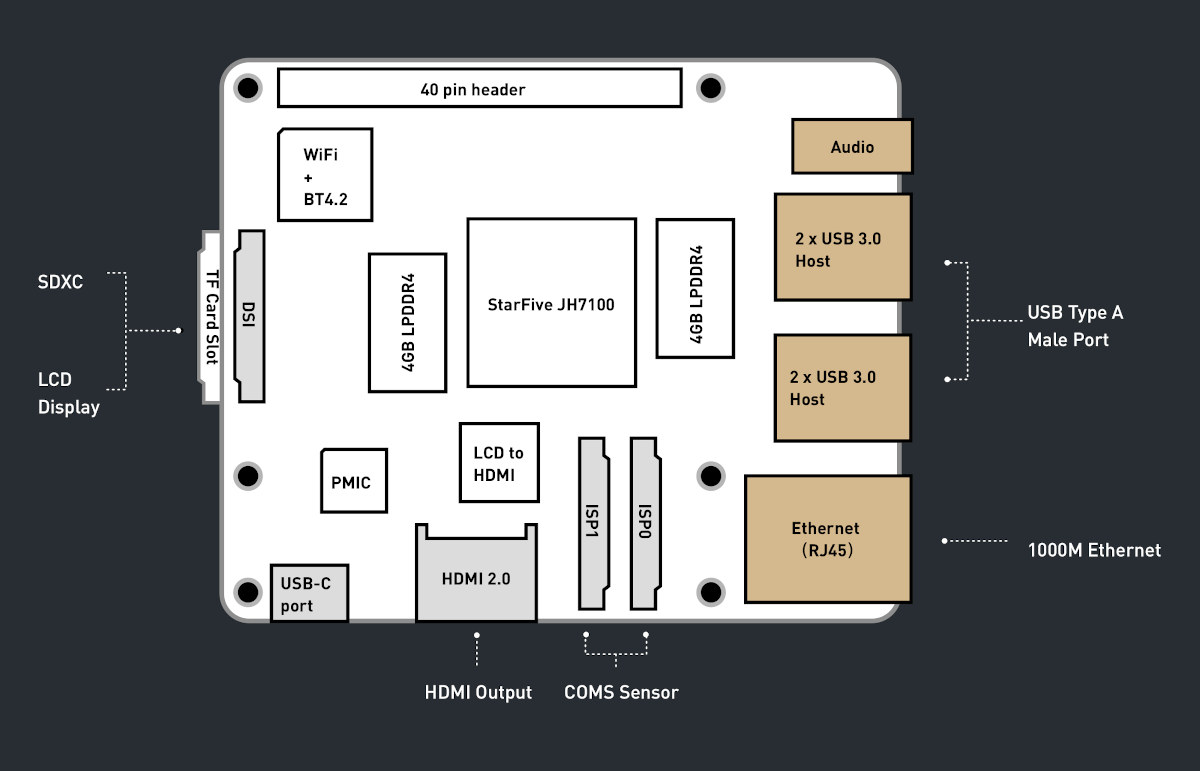Running Linux on RISC-V hardware is already possible, but you’d have a choice of low-end platforms like Kendryte K210 that’s not really practical for anything, or higher-end board like SiFive HiFive Unmatched or PolarBerry for which you’d have to spend several hundred dollars, or even over one thousand dollars to have a complete system.
So an affordable, usable RISC-V Linux SBC is clearly needed. We previously wrote about an upcoming Allwinner RISC-V Linux SBC that will be mostly useful for camera applications without 3D GPU, and a maximum of 256MB RAM. But today, we have excellent news, as the BeagleBoard.org foundation, Seeed Studio, and Chinese fabless silicon vendor Starfive partnered to design and launch the BeagleV SBC (pronounced Beagle Five) powered by StarFive JH7100 dual-core SiFive U74 RISC-V processor with Vision DSP, NVDLA engine, and neural network engine for AI acceleration.

BeagleV specifications:
- SoC – StarFive JH7100 Vision SoC with:
- RISC-V U74 dual-core with 2MB L2 cache @ 1.5 GHz
- Vision DSP Tensilica-VP6 for computing vision
- NVDLA Engine 1 core (configuration 2048 MACs @ 800MHz – 3.5 TOPS)
- Neural Network Engine (1024MACs @ 500MHz – 1 TOPS)
- VPU – H.264/H.265 decoder up to 4Kp60, dual-stream decoding up to 2Kp30
- JPEG encoder/decoder
- Audio Processing DSP and sub-system
- System Memory – 4GB or 8GB LPDDR4
- Storage – MicroSD card slot
- Video output
- 1x HDMI port up to 1080p30
- 1x MIPI DSI interface up to 4Kp30
- MIPI-CSI TX for video output after ISP and AI processing
- Camera
- Dual channels of ISP, each channel support up to 4K @ 30FPS
- 2 x MIPI-CSI Rx
- Audio – 3.5mm audio jack
- Connectivity – 1x Gigabit Ethernet, 2.4 GHz 802.11b/g/n WiFi 4, and Bluetooth 4.2
- USB – 4x USB 3.0 Ports
- Expansion – 40-pin GPIO header with 28 x GPIO, I2C, I2S, SPI, UART
- Security – Support TRNG and OTP
- Misc – Reset and power buttons
- Power Supply – 5V/3A via USB Type-C port
- Dimensions – TBD
Based on our previous article about SiFive U74 core, performance should be similar to Cortex-A55, so a dual-core U74 RISC processor will not have that much processing power compared to other Arm board, but the network accelerator should make it competitive against other AI boards like Coral Dev Board mini.
One obvious item missing from the specifications is a GPU, and I was told while the first batch scheduled in March will be GPU less, but the next batch – slated to be manufactured in September – will come with an Imagination Technologies GPU.
BeagleV will be supported by mainline Linux and a Debian-based software image will be provided. I can also see mentions of Fedora and FreeRTOS. The RISC-V Linux SBC will be open-source hardware just like other boards from the BeagleBoard.org foundation meaning hardware design files, firmware, and the software will be made available publicly.
BeagleV SBC will eventually be sold for $119 with 4GB RAM and $149 with 8GB RAM, but for the first batch, only the version with 8GB RAM will be available. Due to the limited supply, the BeagleBoard.org foundation asks people to fill an application form to provide information about software experience and the expected use for the board. It’s also possible to pre-order the board on Seeed Studio, but you’d still need to fill the application form. Additional information may be found on the product page [Update: pages are down due to the project’s cancellation].

Jean-Luc started CNX Software in 2010 as a part-time endeavor, before quitting his job as a software engineering manager, and starting to write daily news, and reviews full time later in 2011.
Support CNX Software! Donate via cryptocurrencies, become a Patron on Patreon, or purchase goods on Amazon or Aliexpress





